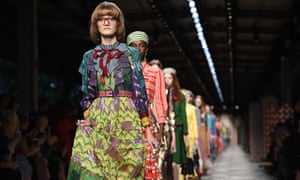New-look Gucci is talk of the town as Milan?s catwalk gets a makeoverPosted by geraline on September 29th, 2015 The fashion industry thrives on the new, on, say, the awkwardly cut trouser that look a bit weird at first, until eventually the eye adjusts. Spotting trends early on is how many people earn their crust – from the retailers who invest in products months before they go on sale to the stylists who coax clients into that challenging Perspex tabard before anyone else. Perhaps this thirst for novelty is why some fashion buyers and editors seem to be stifling a yawn, from time to time, at most Milan fashion weeks. Every fashion capital has its cliches. New York is best-known as a financial powerhouse; Paris is the home of fabled couture brands like Chanel and Dior; London is the wacky, creative little sister. Fashion is so essentially a part of Milan’s identity that upon landing at Linate airport, the first thing visitors see is a hangar sponsored by Emporio Armani. But leaving aside Prada, which has always been quirky and intellectual, Milan is often praised for its heritage and quality, while being accused of promoting a tired, molto sexy view of femininity, and of being a little staid. At this Milan fashion week, something feels different. Many of the venues have changed, for one thing, with Gucci, Pucci and Versace all staging their shows in industrial warehouse-like buildings rather than the purpose-built amphi-theatres within their headquarters. “This is the first time that’s happened in Milan since I started coming as an editor 15 years ago,” says Lorraine Candy of Elle UK. “It feels like quite a New York thing to do.” Though there have been other attempts to revitalise Italian fashion – designers have capitalised on increased footfall around the Milan Expo, brands like Last year, a new creative director, Alessandro Michele, was installed at the ailing Italian megabrand and presented a markedly different collection. Gone were the obvious signifiers of sex and wealth; in came an alternative view of womanhood – bespectacled, androgynous and geeky. The financial effects of this about-turn have yet to be released by the brand’s French owner, Kering, but it has certainly hogged the fashion agenda. It’s the brand all the editors have been wearing on the front row – and if you have wondered why the high street is full of clashing 1970s patterns and pussybow blouses, the answer is Gucci. “Now that Gucci is one of the coolest brands – and a personal favourite – I have to say that I am pretty excited about Milan,” says Justin O’Shea, buying director at luxury retailer Mytheresa. “My impression of Milan has changed in the past two seasons. I feel that for the first time, Italian brands are looking at their heritage with modern eyes.”
Heritage is a thorny issue in Milan, where control often remains in the hands of the same designers for decades – its linchpins include Giorgio Armani, 81, Donatella Versace, 60, Miuccia Prada, 66, and Roberto Cavalli, 74. Cavalli was the setting for another development this season. Roberto, the reigning king of zebra print, had abdicated, appointing Pucci’s Peter Dundas as creative director. But while this was a big move for the business, 90% of which was acquired by an Italian private equity firm in May, the clothes presented stuck pretty firmly to the Cavalli template of ruffles, bodycon and glitz. Clearly, not everything in Milan is going to change. But is this a sign of more to come behind the scenes? “It might shake it up,” says Candy. “It’s just about the business – who is going to create a collection that is going to sell more? The world is changing, and you can buy all of this online now, even in the most remote locations. Brands have to work out what sells best worldwide, and the designer who does that won’t necessarily be a member of the family.” Not all attempts at reinvention have worked. At Pucci – where a new creative director, Massimo Giorgetti, replaced Dundas – critics asked whether the Gucci influence was too literal, with hairy shoes and geeky glasses in abundance, and Pucci’s signature 1960s swirls mainly absent. “Trends come and go and Milan should not get into a battle of ‘trendiness’ as it is one they won’t win,” says O’Shea, “So the idea of focusing on heritage is what makes Milan fashion very ‘now’. They don’t need to reinvent the wheel, just capture the spirit of their brand in the moment of time which fashion is living in.” The wider mood in fashion seems to be one Milan’s original fashion intellectual, Miuccia Prada, anticipated decades ago: a thirst for quirkiness, intelligence and individuality, rather than obvious glamour and sexiness. This is expressed in the success of under-the-radar brands, and the in use of women like 80-year-old Joan Didion as major campaign stars. This year, even the calendar published by Milanese tyre brand Pirelli – which features photographs of scantily clad models, produced with a veneer of artiness by virtue of fashion’s top stylists and photographers – will be using Yoko Ono and Patti Smith as its pin-ups. Capturing a bit of this spirit, while staying true to the brand, is what Versace managed to pull off on Friday night, showing the designer’s trademark glitzy dresses alongside more unusual offerings and against a soundtrack of female empowerment. After the show, one fashion editor could be heard proclaiming: “I loved that. That was my favourite show in Milan. Oh, apart from maybe Prada. And Gucci. Actually I don’t know which I loved more.” See more Abiti da Sera Economici Online Like it? Share it! |



